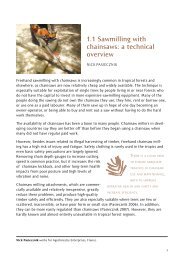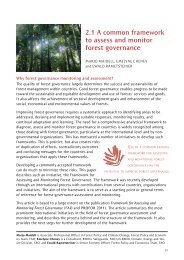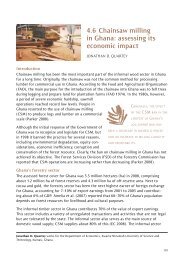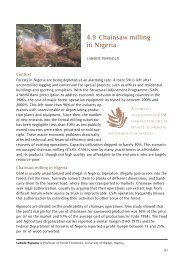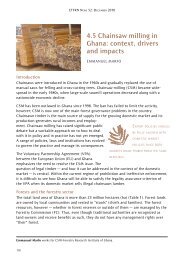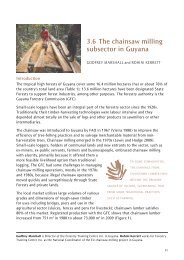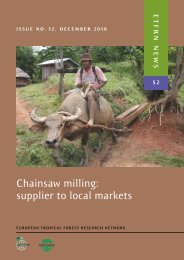Chainsaw milling: supplier to local markets - European Tropical ...
Chainsaw milling: supplier to local markets - European Tropical ...
Chainsaw milling: supplier to local markets - European Tropical ...
You also want an ePaper? Increase the reach of your titles
YUMPU automatically turns print PDFs into web optimized ePapers that Google loves.
10<br />
ETFRN NEws 52: DEcEmbER 2010<br />
usa Granberg mark iii – oak 0.6–1.2 — henderson and krier,<br />
1997<br />
kenya Granberg mark iii -<br />
prosopis<br />
0.27 25% samuel, pasiecznik and<br />
Fehr 2007<br />
australia Frame and rail mills — 55% smorfitt et al. 2004<br />
Carriage mills<br />
sweden logosol m7 – softwood 2.3—3.5 50—60% Company website<br />
Canada procut “make your own” 3 1.8—3.6 — Company website<br />
uk Jonsered 600+ 4 —<br />
Douglas fir<br />
Canada procut “make your own”<br />
— softwoods<br />
1.6—2.9 26—66% Jones, 1998<br />
1.2—2.4 — Company website<br />
uk Jonsered 600+ 4 – oak 1.1 56% Jones, 1998<br />
new Zealand Fri mill – rimu 1.0 52% James, 1985<br />
Canada procut “make your own”<br />
— hardwoods<br />
0.6—1.2 — Company website<br />
source: adapted from samuel, pasiecznik and Fehr 2007<br />
1. For source references, please refer <strong>to</strong> samuel, pasiecznik and Fehr (2007), Table 1.2 (page 8).<br />
2. including: Granberg mark iii, westford rail mill, beerwah ripper mk iV, macQuarrie Chain mill, logosol.<br />
3. using a stihl 090, one man helping, averaged over seven years (www.procutportablesawmills.com/production.htm).<br />
4. now marketed as the lennartsfors sm 2196.<br />
a study in Dr Congo (in samuel, pasiecznik and Fehr 2007) compared the economic<br />
viability of producing timber freehand and with a frame mill. it found that, although<br />
timber from a frame mill was of higher quality, that there was no <strong>local</strong> market for such<br />
timber, and the price premium that could be obtained in the non-<strong>local</strong> market was largely<br />
spent on transport. although frame mills had a higher rate of recovery, logs were abundant,<br />
and thus there was little motivation for using <strong>milling</strong> attachments in the region.<br />
The literature on this <strong>to</strong>pic is sparse, however, and more site-specific research is required<br />
in various forest and non-forest regions.<br />
Each <strong>milling</strong> attachment has its own advantages in different situations. Table 3 summarizes<br />
these related <strong>to</strong> the type of timber required and logs available. rail mills provide<br />
a simple means for an infrequent user <strong>to</strong> guarantee a straight board, and are used for<br />
edging timber or producing beams. These mills can be purchased very cheaply (less than<br />
us$50), but there are benefits in using a rail and frame mill in combination. Frame mills<br />
have a wide range of uses, are able <strong>to</strong> process both very small and very large diameter and<br />
even crooked logs, and they are also relatively cheap and very efficient with medium-size<br />
logs. although the Gruminette and westford slabbing mill have certain advantages,<br />
Granberg’s range of frame mills generally offers a good choice at a reasonable cost.



